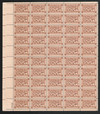
# 1071 - 1955 3¢ Fort Ticonderoga
1955 3¢ Fort Ticonderoga
City: Fort Ticonderoga, New York
Quantity: 118,664,00
Printed by: Bureau of Engraving and Printing
Printing Method: Rotary Press
Perforations: 11 x 10 ½
Color: Light brown
The Capture Of Fort Ticonderoga
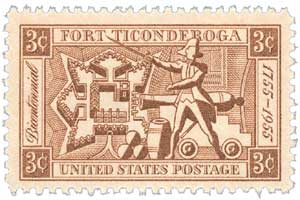
On May 10, 1775, Ethan Allen and Benedict Arnold led a small colonial militia to capture Fort Ticonderoga from the British.
Fort Ticonderoga has been nicknamed “The Key to a Continent.” The fort earned this name due to its strategic location on Lake Champlain in New York; it controlled the water route from Lake Champlain to Lake George. In Colonial days, almost everything had to move by water. So this route was essential for any invading force coming into the colonies from Canada. The French built the fort in 1755 but lost it to the British during the French and Indian War.
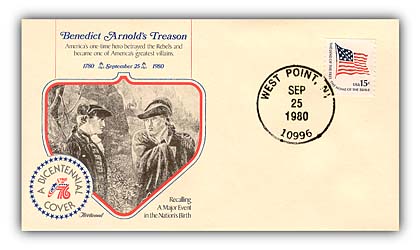
By the start of the American Revolution, the fort did not appear to have as much strategic importance as it had in the past. The fort only housed a small detachment of two officers, 46 men, and 25 women and children. Although the fort had fallen into disrepair, it was heavily stocked with cannons, howitzers, mortars, and other heavy artillery the American patriots needed. On May 3, 1775, the Massachusetts Committee of Safety gave Benedict Arnold a colonel’s commission and put him in charge of a “secret mission” to capture the fort.
At the same time, Ethan Allen and the Green Mountain Boys of Vermont were on their way to the fort for the same reason. Although Arnold had formal authorization for the capture, he and Allen agreed to work together.
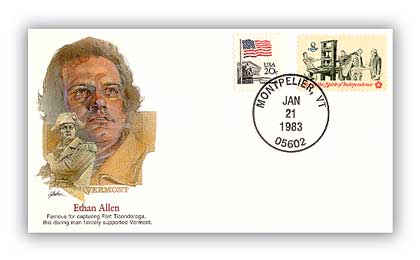
After approaching by water in the early hours of May 10, 1775, the patriots stormed the fort, waking the sleeping troops at gunpoint and confiscating their weapons. Allen, Arnold, and a few others stormed the officers’ quarters, first encountering Lieutenant Jocelyn Feltham, assistant to Captain William Delaplace. When asked on whose authority they were entering the fort, Allen replied, “In the name of the Great Jehovah and the Continental Congress.”
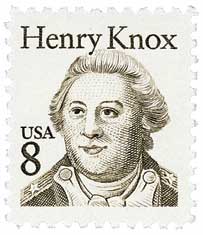
When Delaplace emerged from his quarters, he was fully dressed and willingly surrendered his sword. No one was killed in the capture, though a bayonet injured one American. For years after the capture, Allen and Arnold had a war of words over which one deserved the most credit, offering varying accounts of the day. Later in 1775, Henry Knox would transport the heavy weapons captured at Ticonderoga to Boston for the Continental Army.
Two years later, in June 1777, British General John Burgoyne launched his Saratoga Campaign, aimed at dividing the rebel colonies. Part of his plan included retaking Fort Ticonderoga before proceeding down the Hudson River Valley. With an army of about 7,000 regulars and 800 Native Americans, he greatly outnumbered the 2,500 understrength American defenders. On July 2 there was a brief skirmish, during which there were no injuries or damage, but one British soldier was captured and tricked into revealing the size of the attacking force.

In the meantime, the British discovered nearby Sugar Loaf, a mountain overlooking Ticonderoga that would prove strategically useful. They quietly began moving large weapons up the mountain and prepared for a surprise attack that they would launch when German Baron Riedesel was in a position to attack the retreating Americans. However, on July 4 British-allied Native Americans lit fires on the mountain, alerting the Americans to their presence.
Completely outnumbered, the American General Arthur St. Clair knew he had a tough decision, stating he could “save his character and lose the army” by defending the fort or “save the army and lose his character” by retreating. He chose the latter and planned to evacuate the following night under the cover of darkness. His men filled more than 200 boats with weapons, injured soldiers, civilians, and supplies. The remainder of the army then evacuated the fort and crossed to Mount Independence toward Castleton. The British took the fort without firing a shot on July 6, though there were small skirmishes and battles in the area in the days that followed.
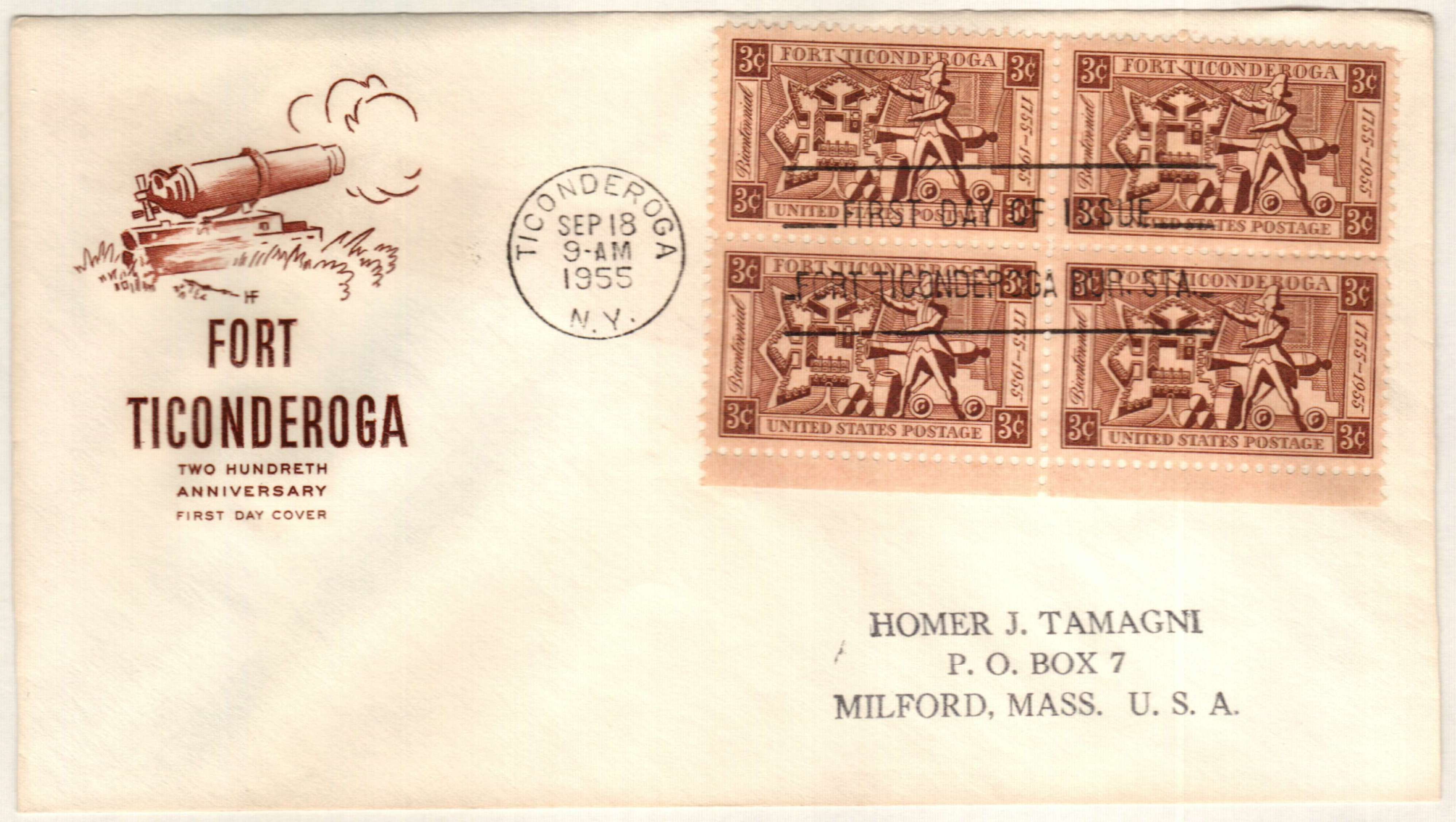
The British victory at Ticonderoga became world news. King George reportedly exclaimed, “I have beat them! I have beat all Americans!” and threatened the French and Spanish to close their ports to America. While the time at Ticonderoga did not slow Burgoyne on his journey to Saratoga, he left more than 900 men behind there.
In September, American General Benjamin Lincoln would lead an attack on Ticonderoga, though he was later called back. The British left Ticonderoga in November and Lake Champlain was free of their troops by the following month.
After the war, the fort was dismantled; its stone was used locally for building. It was rebuilt in 1908, and a museum was opened there.
Click here for more about Fort Ticonderoga.
1955 3¢ Fort Ticonderoga
City: Fort Ticonderoga, New York
Quantity: 118,664,00
Printed by: Bureau of Engraving and Printing
Printing Method: Rotary Press
Perforations: 11 x 10 ½
Color: Light brown
The Capture Of Fort Ticonderoga

On May 10, 1775, Ethan Allen and Benedict Arnold led a small colonial militia to capture Fort Ticonderoga from the British.
Fort Ticonderoga has been nicknamed “The Key to a Continent.” The fort earned this name due to its strategic location on Lake Champlain in New York; it controlled the water route from Lake Champlain to Lake George. In Colonial days, almost everything had to move by water. So this route was essential for any invading force coming into the colonies from Canada. The French built the fort in 1755 but lost it to the British during the French and Indian War.

By the start of the American Revolution, the fort did not appear to have as much strategic importance as it had in the past. The fort only housed a small detachment of two officers, 46 men, and 25 women and children. Although the fort had fallen into disrepair, it was heavily stocked with cannons, howitzers, mortars, and other heavy artillery the American patriots needed. On May 3, 1775, the Massachusetts Committee of Safety gave Benedict Arnold a colonel’s commission and put him in charge of a “secret mission” to capture the fort.
At the same time, Ethan Allen and the Green Mountain Boys of Vermont were on their way to the fort for the same reason. Although Arnold had formal authorization for the capture, he and Allen agreed to work together.

After approaching by water in the early hours of May 10, 1775, the patriots stormed the fort, waking the sleeping troops at gunpoint and confiscating their weapons. Allen, Arnold, and a few others stormed the officers’ quarters, first encountering Lieutenant Jocelyn Feltham, assistant to Captain William Delaplace. When asked on whose authority they were entering the fort, Allen replied, “In the name of the Great Jehovah and the Continental Congress.”

When Delaplace emerged from his quarters, he was fully dressed and willingly surrendered his sword. No one was killed in the capture, though a bayonet injured one American. For years after the capture, Allen and Arnold had a war of words over which one deserved the most credit, offering varying accounts of the day. Later in 1775, Henry Knox would transport the heavy weapons captured at Ticonderoga to Boston for the Continental Army.
Two years later, in June 1777, British General John Burgoyne launched his Saratoga Campaign, aimed at dividing the rebel colonies. Part of his plan included retaking Fort Ticonderoga before proceeding down the Hudson River Valley. With an army of about 7,000 regulars and 800 Native Americans, he greatly outnumbered the 2,500 understrength American defenders. On July 2 there was a brief skirmish, during which there were no injuries or damage, but one British soldier was captured and tricked into revealing the size of the attacking force.

In the meantime, the British discovered nearby Sugar Loaf, a mountain overlooking Ticonderoga that would prove strategically useful. They quietly began moving large weapons up the mountain and prepared for a surprise attack that they would launch when German Baron Riedesel was in a position to attack the retreating Americans. However, on July 4 British-allied Native Americans lit fires on the mountain, alerting the Americans to their presence.
Completely outnumbered, the American General Arthur St. Clair knew he had a tough decision, stating he could “save his character and lose the army” by defending the fort or “save the army and lose his character” by retreating. He chose the latter and planned to evacuate the following night under the cover of darkness. His men filled more than 200 boats with weapons, injured soldiers, civilians, and supplies. The remainder of the army then evacuated the fort and crossed to Mount Independence toward Castleton. The British took the fort without firing a shot on July 6, though there were small skirmishes and battles in the area in the days that followed.

The British victory at Ticonderoga became world news. King George reportedly exclaimed, “I have beat them! I have beat all Americans!” and threatened the French and Spanish to close their ports to America. While the time at Ticonderoga did not slow Burgoyne on his journey to Saratoga, he left more than 900 men behind there.
In September, American General Benjamin Lincoln would lead an attack on Ticonderoga, though he was later called back. The British left Ticonderoga in November and Lake Champlain was free of their troops by the following month.
After the war, the fort was dismantled; its stone was used locally for building. It was rebuilt in 1908, and a museum was opened there.
Click here for more about Fort Ticonderoga.






